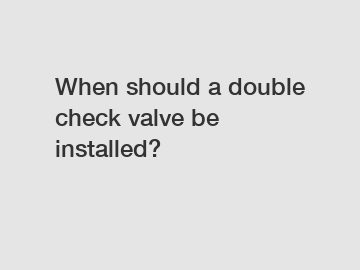When should a double check valve be installed?
When should a double check valve be installed?
A double check valve is an essential component in a plumbing system that helps prevent backflow of water. It acts as a protective barrier, ensuring that contaminated water does not flow back into the clean water supply. But when exactly should one consider installing a double check valve? Let's explore this topic further.
1. Legal requirements: Double check valves are often mandatory in certain jurisdictions. It is crucial to be aware of the local regulations and building codes governing backflow prevention. In many cases, installing a double check valve becomes a legal requirement, particularly in commercial or industrial settings where there is a higher risk of cross-connections.

2. Degree of potential contamination: The decision to install a double check valve should also be based on the degree of potential contamination. For instance, if you have an irrigation system connected to your potable water supply, the use of pesticides or chemicals in the irrigation process may pose a significant risk of backflow. In such cases, installing a double check valve can provide an additional layer of protection against potential contamination.
3. Type of cross-connections: Understanding the type and frequency of cross-connections in your plumbing system is vital for determining when to install a double check valve. Cross-connections occur when there is a connection between the clean water supply and a source of contamination, such as a swimming pool, fire sprinkler system, or garden hose. If your premises have multiple cross-connections, it is advisable to install a double check valve to prevent any backflow incidents.
4. Sensitive environments: Certain environments are particularly sensitive to the risk of contamination. Hospitals, laboratories, food processing facilities, and pharmaceutical manufacturing units are examples of places where maintaining water purity is of utmost importance. In such settings, a double check valve is often a necessary component to prevent contamination and protect public health.
5. Existing backflow prevention measures: Before deciding to install a double check valve, it is crucial to evaluate the effectiveness of any existing backflow prevention measures. If your plumbing system already has an approved backflow prevention device, it might be sufficient to meet the requirements. However, in situations where the risk of contamination remains high or the current device is outdated, installing a double check valve can enhance the system's efficiency.
6. Past incidents or water quality issues: If a property has previously experienced backflow incidents or water quality issues, it is imperative to take appropriate measures to prevent the recurrence. Installing a double check valve becomes crucial in such cases to avoid potential health hazards and legal consequences.
7. Changes in water use: Any significant changes in water use patterns can also warrant the installation of a double check valve. For instance, if you are converting a residential property into a daycare or healthcare facility, the increased risks associated with the new water usage require additional preventative measures. Installing a double check valve will help maintain the integrity of the water supply and ensure the safety of occupants.
In conclusion, the installation of a double check valve should be considered when there are legal requirements, a high risk of contamination, multiple cross-connections, sensitive environments, inadequate existing backflow prevention measures, past incidents, or changes in water use. It is essential to consult with a professional plumber or backflow specialist to assess the specific requirements of your plumbing system and ensure compliance with local regulations. By installing a double check valve, you can safeguard the purity of your water supply and protect the health of individuals using the plumbing system.
For more information, please visit customized non rising stem ductile iron gate valve, cast iron gate valve china, din strainer.
240
0
0

Comments
All Comments (0)